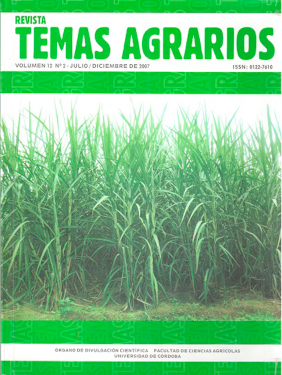Ischaemum rugosum Salisb. germination reaction to environmental and chemical stimuli
Germinación de Ischaemum rugosum Salisb. en respuesta a estimulos ambientales y químicos

This work is licensed under a Creative Commons Attribution-NonCommercial 4.0 International License.
Show authors biography
The effect of temperature, light, metabolic substances and scarification on the Ischaemum rugosum Salisb germination were evaluated. The germination tests were performed in germination boxes with distilled water using a completely randomized design with three replicates. The results indicated that the after the imbibition phase Ischaemum rugosum Salisb., presents a latency period or ¨plateau¨ about 12 to 48 hour after water adsorption is initiated. Germination percentages were affected significantly by extreme temperatures (10 and 50 °C), the far-red light exposure had a positive effect on the number of germinated seeds (Pr< 0.05). Scarification had a significant effect on emergency with respect to chemical treatment. Metabolic substances, such as gibberellins (AG 3) and Potassium Nitrate (KNO3), showed higher emergency percentages. Based on the results, it can be inferred that Ischaemum rugosum Salisb. seeds present a typical photoblastic species behavior and the importance of physical factors, such as absence of the seed coat and the stimulus of metabolic substances on seed germination.
Article visits 1854 | PDF visits
Downloads
- Azcón-Bieto, J. y M, Talón. 2003. Fundamentos de Fisiología Vegetal. McGraw-Hill Interamericana, Ciudad de edición? 450 p.
- Bakar, B. 2007. Bipyridiliums (group D/22) resistant saramollagrass (Ischaemum rugosum) Malaysia. http://www.weedscience.org/Case/ Case.asp?ResistID=139. [Accedido: 06-04-07]
- Bakar, B. y Ahmed, L. 2003. Seed germination, seedling establishment and growth patterns of wrinklegrass (Ischaemum rugosum Salisb.) Weed Biology and Management 3:8-14
- Baki, B. 1986. The population biology of Oxalis corniculata L. Tesis, Ph.D, University of Wales, Bangor
- Baki, B. 1988. The seed population dynamics of barnyardgrass [Echincohloa crusgalli (L.) P. Beauv.]. Proceedings of the National Seminar on Rice Weed Management (Penang, Malaysia 7-9 Junio, 1988). Malaysian Agricultural Research and Development Institute, Serdang, 299-314.
- Baki, B. 1992. Ischaemum rugosum Salisb. En: Mannetje L. y Jones R. (Ed.). Plant
- Resources of South-East Asia, Forages. Pudoc Scientific Publishers, Wageningen, 146-148.
- Baskin, C. y Baskin, J. 2001a. Constant versus alternating temperature regimes. Seeds. Ecology, Biogeography and Evolution of Dormancy and Germination. Academic Press, California, p12-13
- Baskin, C. y Baskin, J. 2001b. Environmental factors causing changes in dormancy states. Seeds. Ecology, Biogeography and evolution of dormancy and germination. Academic Press. California -USA. 666 p. pp. 73-76.
- Berrie, A. 1987. Plant Physiology. English Language Book Society, Longmans, Londres, 440-468.
- Bewley, J. y Black, M. 1994. Seeds: Physiology of development and germination. Plenum Press, New York, 445p.
- Clavijo, J. y Medina, H. 2004. Impacto socioeconómico de las malezas en el cultivo de arroz en Colombia. Revista Comalfi 31(1):13-23
- Clavijo, J.; Montenegro, L.; Medina, J.; Barragán, E. y Duarte, C. 2004. Determinación de la inhibición y de la influencia de cuatro factores en la germinación de falsa caminadora Ischaemum rugosum Salisb. Revista Arroz 52(451):4-12
- Clayton, W.; Harman, K. y Williamson, H. 2005. Ischaemum rugosum. Copyright The Board of Trustees, Royal Botanic Gardens, Kew. En: World Grass Species - Ischaemum rugosum Description. http://www.kew.org/data/grasses-db/www/imp05784.htm [Accedido: 09-28-2006]
- Cohn, M.; Butera, D. y Hughes, J. 1983. Seed dormancy in Red Rice. III. Response to nitrite, nitrate and ammonium ions. Plant Physiology 73:381-384
- Cohn, M. 1987. Mechanisms of physiological seed dormancy. En: Frasier,G. Y Evans R. (Ed). Seed and seedbed ecology of rangeland plants. USDAARS, Washington, D.C. 311p
- Hill, N.M.; Patriquin, D. y Vander-Kloet, S. 1989. Weed seed bank and vegetation at the beginning and end of the first cycle of a four-course crop rotation with minimal weed control. Journal of Applied Ecology. 26: 233-246.
- Moreno, F.; Plaza, G. y Magnitskiy, S. 2006. Efecto de la testa sobre la germinación de semillas de caucho (Hevea brasiliensis Muell.). Agronomía Colombiana 24(2):290-295
- Nabi, L. 1999. The population biology of wrinklegrass (Ischaemum rugosum Salisb.). Tesis Ph. D., University of Malaya, Kuala Lumpur
- Pons, T. 2000. Seed responses to light. En: Fenner, M (Ed). Seeds: The Ecology of Regeneration in Plant Communities. CAB International, New York, NY
- Rao, A. y Moody, K. 1995. Effect of seeding depth and soil moisture regimes on emergence of Ischaemum rugosum Salisb. and Echinochloa glabrescens. Proceedings of the 15th Asian–Pacific Weed Science Society Conference, Asian-Pacific Weed Science SocietyPublication, 520-522
- Salisbury, F. y Ross, C. 2000. Fisiología de las Plantas. Editorial Paraninfo Thomson Learning, Madrid, 988p.
- Suárez, C. 1983. Estudio de algunos factores fisiológicos en germinación de pasto carimagua (Andropogon gayanus Kunth.). Tesis M. Sc. Universidad Nacional de Colombia, Bogotá
- Suárez, L.; Anzalone, A. y Moreno, O. 2004. Evaluación del herbicida halosulfuronmetil para el control de malezas en el cultivo de arroz (Oryza sativa L.).
- Torres, J. y Guzmán, P. 2003. Morfología de plántulas y fenología de algunas malezas gramíneas de importancia en campos de arroz del Norte de Tolima. Arroz. 51 (446):14
- USDA - NRCS. 2005. Murainagrass. Identification, Biology, Control and Management Resources. http://www.lucidcentral.org/keys/FNW/FNW%20grasses/html/fact%20sheets/Ischaemum%20rugosum.html
- Valverde, B. 2007. ACCase inhibitors (groupA/1) resistant saramollagrass (Ischaemum rugosum) http:// w w w . w e e d s c i e n c e . o r g / C a s e / Case.asp?ResistID=5143. [Accedido: 06-04-07]




















